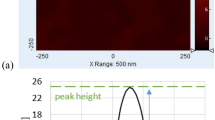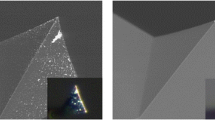Abstract
The distribution of sizes is one of the basic characteristics of nanoparticles. Here, we propose a novel way to determine the lateral distribution of sizes from AFM topographies. Our algorithm is based on the autocorrelation function and can be applied both on topographies containing spatially separated and densely packed nanoparticles as well as on topographies of polycrystalline films. As no manual treatment is required, this algorithm can be easily automatable for batch processing. The algorithm works in principle with any kind of spatially mapped information (AFM current maps, optical microscope images, etc.), and as such has no size limitations. However, in the case of AFM topographies, the tip/sample convolution effects will be the factor limiting the smallest size to which the algorithm is applicable. Here, we demonstrate the usefulness of this algorithm on objects with sizes ranging between 20 nm and 1.5 μm.




Similar content being viewed by others
References
Buijnsters JG, Vázquez L (2011) Growth dynamics of nanocrystalline diamond thin films deposited by hot filament chemical vapor deposition: influence of low sticking and renucleation processes. J Phys Chem C 115(19):9681–9691. doi:10.1021/jp201919r
Carpenter DT, Rickman JM, Barmak K (1998) A methodology for automated quantitative microstructural analysis of transmission electron micrographs. J Appl Phys 84(11):5843–5854. doi:10.1063/1.368898. Although this article deals with TEM images, it tackles the same problem usually encountered in AFM topographies, i.e. the network of densely packed particles
Casciato M, Levitin G, Hess D, Grover M (2012) Controlling the properties of silver nanoparticles deposited on surfaces using supercritical carbon dioxide for surface-enhanced Raman spectroscopy. J Nanopart Res 14:1–15. doi:10.1007/s11051-012-0836-2
Chakraborty M, Dasgupta S, Sengupta S, Chakraborty J, Ghosh S, Ghosh J, Mitra MK, Mishra A, Mandal TK, Basu D (2012) A facile synthetic strategy for Mg–Al layered double hydroxide material as nanocarrier for methotrexate. Ceram Int 38(2):941–949. ISSN 0272-8842. doi:10.1016/j.ceramint.2011.08.014 (2012)
Cremona M, Mauricio MHP, Scavarda do Carmo L, Prioli R, Nunes V, Zanette S, Caride AO, Aluquerquie MP (2000) Grain size distribution analysis in polycrystalline LiF thin films by mathematical morphology techniques on AFM images and X-ray diffraction data. J Microsc 197(3):260–267. doi:10.1046/j.1365-2818.2000.00661.x
Dohnalová K, Žídek K, Ondič L, Kůsová K, Cibulka O, Pelant I (2009) Optical gain at the F-band of oxidized silicon nanocrystals. J Phys D Appl Phys 42:135102. doi:10.1088/0022-3727/42/13/135102
Gaebel T, Bradac C, Chen J, Say J, Brown L, Hemmer P, Rabeau J (2012) Size-reduction of nanodiamonds via air oxidation. Diam Relat Mater 21:28–32. doi:10.1016/j.diamond.2011.09.002
Ghasemi A (2012) Magnetic properties of substituted strontium ferrite nanoparticles and thin films. J Magn Magn Mater 324(7):1375–1380. doi:10.1016/j.jmmm.2011.11.044
Guidelli EJ, Ramos AP, Zaniquelli MED, Nicolucci P, Baffa O (2012) Synthesis of silver nanoparticles using DL-alanine for ESR dosimetry applications. Radiat Phys Chem 81(3):301–307. doi:10.1016/j.radphyschem.2011.10.020
Kůsová K, Cibulka O, Dohnalová K, Pelant I, Valenta J, Fučíková A, Žídek K, Lang J, Englich J, Matějka P, Štěpánek P, Bakardjieva S (2010) Brightly luminescent organically capped silicon nanocrystals fabricated at room temperature and atmospheric pressure. ACS Nano 4(8):4495–4504. doi:10.1021/nn1005182
Machado AHE, Lundberg D, Ribeiro AJ, Veiga FJ, Lindman B, Miguel MG, Olsson U (2012) Preparation of calcium alginate nanoparticles using water-in-oil (w/o) nanoemulsions. Langmuir 28(9):4131–4141. doi:10.1021/la204944j
Meng H, Zhao F, Zhang Z (2012) Preparation of cobalt nanoparticles by direct current arc plasma evaporation method. Int J Refract Metals Hard Mater 31(0):224–229. doi:10.1016/j.ijrmhm.2011.11.007
Osma-Ruiz V, Godino-Llorente JI, Sáenz-Lechón N, Gómez-Vilda P (2007) An improved watershed algorithm based on efficient computation of shortest paths. Pattern Recognit 40(3):1078–1090. doi:10.1016/j.patcog.2006.06.025
Easton RL Jr (2010) Fourier methods in imaging. Wiley/Chester F. Carlson Center for Imaging Science, Rochester
Taylor A, Fendrych F, Fekete L, Vlček J, Řezáčová V, Petrák V, Krucký J, Nesládek M, Liehr M (2011) Novel high frequency pulsed mw-linear antenna plasma-chemistry: routes towards large area, low pressure nanodiamond growth. Diam Relat Mater 20(4):613–615. doi:10.1016/j.diamond.2011.01.003
Acknowledgments
This work was supported by the Technological Agency of the Czech Republic through Grant No. TACR TA01011165, the Czech Science Foundation through Grant No. P304/10/1951, GA CR through Grant No. P204/12/P235, and the Academy of Sciences of the Czech Republic through Grant No. KAN200100801.
Author information
Authors and Affiliations
Corresponding author
Appendix
Appendix
The ACF function from Eq. (2), where \(\langle f(x)\rangle\) stands for averaging of f over all x’s: \(\int f(x)\hbox{d} x\), is a measure of spatial correlation of an image with itself. It is a function of displacement coordinates \((\Updelta x, \Updelta y)\); the convention that variable names prefixed with \(\Updelta\) are used for the coordinates of ACF is used throughout this article.
The geometrical meaning of ACF can be most easily inferred directly from Eq. (2) for the case of a single object located in the middle of a studied image h(x,y) (of square shape for the sake of simplicity). According to Eq. (2), if we take two copies of this image, place them one over another, multiply the height values at the corresponding pixels, and compute the integral under the resulting curve \(\int h(x,y)^2 \hbox{d}x \hbox{d} y\), we get the value of ACF for zero displacement \((\Updelta x,\Updelta y)=(0,0)\,\hbox{nm}\). Then, we shift one of the copies of the image by one pixel in the x direction, repeat the above integration, and get the value of ACF for the displacement \((\Updelta x,\Updelta y)=(\Updelta x_0,0)\), where \(\Updelta x_0\) corresponds to the distance between two pixels in the x direction. If this procedure is repeated for all possible displacements of the two copies of the studied image, we get the whole 2D ACF map.
The most important properties of the ACF function are two-fold axis of rotational symmetry
and independence of the origin of the coordinate system
both of which can be easily inferred directly from Eq. (2). (Although the ACFs computed from an AFM topography are, technically speaking, discrete, these most important properties apply also to the discrete case.)
If two objects f 1(x 1,y 1) and f 2(x 2,y 2) centered at different locations (x 1,y 1) and (x 2,y 2) are present in the studied topography h = f 1 + f 2, the resulting ACF will be composed of the ACFs of the individual objects and their cross-correlation:
The two autocorrelation terms will be, based on Eq. (A2), centered at \((\Updelta x, \Updelta y)=(0,0)\,\hbox{nm}\), while the cross-correlation term \(\langle{\langle{f_1,f_2}\rangle}\rangle\) will be located away from the center of the 2D ACF at \((\Updelta x, \Updelta y)=(|x_1-x_2,y_1-y_2|)\). This implies that the off-center part of the ACF of an AFM topography describes the spatial distribution of the grains and should be more or less constant for a homogeneous coverage. In contrast, the central part contains information about (i.e., the ACFs of) all the grains because the principle described in Eq. (A3) is generally valid for more than two objects present in the studied image. However, in real-life topographies, the objects (say again f 1 and f 2) are usually very close to one another, causing that the autocorrelation terms \(\langle{\langle{f_{1/2},f_{1/2}}\rangle}\rangle\) might spatially overlap with the cross-correlation term \(\langle{\langle{f_1,f_2}\rangle}\rangle\). In such a case, it is useful to shift the height axis of the whole image h 1(x, y) = f 1(x, y) + f 2(x, y) − h 0 by its mean height value h 0; thus, the off-center part of the overall ACF \(\langle{\langle{h_1}\rangle}\rangle\) levels out. The single-object central part becomes recognizable as the part before the rACF drops to the first local minimum already when only a few objects are present and the AFM topography is “normalized” to attain zero mean value.
One of basic shapes the 2D ACF of which can be expressed analytically is a cylinder with the diameter d 0
Its 2D ACF can be derived (e.g., by means of the Hankel-transform formalism) to be a “circular” triangle function (Easton 2010) (sometimes referred to as the Chinese-hat function or Chat for short)
where
The purpose of the cylinder function is to set to zero all the values where the arccos function or the square-root term can be undefined or complex, respectively; also, note the quadratic dependence of the ACF amplitude on the diameter of the object. By means of this definition, the Chat function has unitary amplitude at \(\Updelta r=0 \,\hbox{nm}\). The Chat function is plotted in Fig. 4b.
It is also important to stress here that the radial ACF from Eq. (3) should not be confused with height–height correlation function HHCF
[see e.g.,(Buijnsters and Vázquez 2011)] useful for the characterization of surface roughness.
Rights and permissions
About this article
Cite this article
Fekete, L., Kůsová, K., Petrák, V. et al. AFM topographies of densely packed nanoparticles: a quick way to determine the lateral size distribution by autocorrelation function analysis. J Nanopart Res 14, 1062 (2012). https://doi.org/10.1007/s11051-012-1062-7
Received:
Accepted:
Published:
DOI: https://doi.org/10.1007/s11051-012-1062-7




